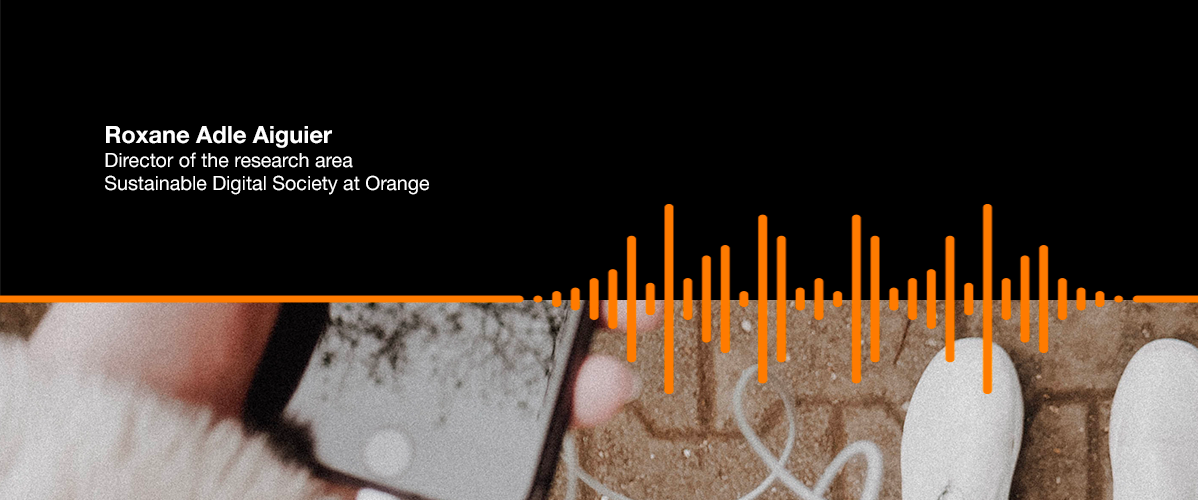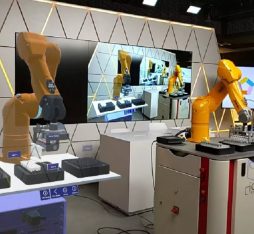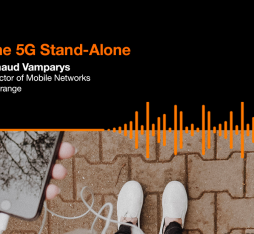With this in mind, Orange has designed an overarching architecture, taking into account data security and confidentiality, quality of service management, and traffic flows in the context of multiple access networks and multiple car manufacturers. It will even work for cross-border journeys.
Jérôme Colombain: We’re here to talk about driverless cars. An increasing number of trials are happening all over the world, from individual vehicles to group shuttle services and even small delivery robots. To ensure that they are completely autonomous while being as safe as possible, these vehicles need to be connected: connected to communicate and exchange information, such as traffic conditions, with road infrastructure and other vehicles.
This is how 5G will be used in autonomous or even semi-autonomous vehicles. We talk about them right here with Roxane Adle, Head of Sustainable Digital Society Research at Orange. To begin, we’ll go right back to basics. Roxane, what exactly is meant by a driverless car?
Roxane Adle-Aiguier: Well, there are different levels of driverless cars. The levels go from 1 to 5, starting from park assist, moving to the possibility of letting go of the wheel on a motorway, all the way to the fully automated shuttles that we see today, for example, at the Plateau de Saclay or at some airports. We are currently working on all of these challenges, with the goal of eventually producing a truly driverless car, like the ones we see in science fiction movies and books.
JC: There is one question that people often ask. Why driverless cars? What’s the point? Considering there are people who really like driving!
RA: Yes, there are indeed people who really like driving.
JC: Is safety the reason?
RA: There are three reasons. You’re right about safety. We hope to have zero deaths on the road by 2050. That is the first reason. The second reason is what everyone is focused on: making the most of the time freed up from driving to do other things. That could be a hobby or work, anything you like, other than driving. And the third is simply to relax, spend time and chat with other people without paying attention to the road.
JC: It will be like being on a train, but in your car.
RA: Exactly.
JC: Tell me Roxanne Adle, why use 5G in driverless vehicles?
RA: As I said, there are currently shuttles that are autonomous, rather than completely autonomous (meaning they do not have drivers, but they have an operator instead in case of emergencies). By law, they do not go faster than 30 km/h. Networks can be used to increase the capabilities of these semi-autonomous cars that we see today by adding sensors and LiDAR (Light Detection and Ranging software), which detect obstacles or hazards that cannot be seen by the driver or detected by the car’s sensors.
JC: But how?
RA: A discussion takes place between connected cars, their environment, other connected cars and objects — both connected and unconnected. For example, when a car drives past an obstacle, it can send a signal to all the cars around it on the same road, saying “caution, a car has stopped on the road or there is a traffic jam,” so that other cars receiving this alert, even before the obstacle is visible, can begin to slow down and possibly detect obstacles, a collision or a traffic jam.
JC: That is what’s called “vehicle to vehicle” communication.
RA: Exactly, this is “vehicle to vehicle” communication.
JC: And so 5G is the only solution?
RA: It’s not; we began work in this area 12 years ago, starting with 4G. But it’s true that 5G provides us with additional features, for example, being able to reserve slices of particular networks for cars — slices with low latency and high speeds. That way, if someone in the backseat of a car, such as a child, is watching a film and using the network, these different emergency and non-emergency uses are kept separate from each other.
JC: And that’s the big advantage of 5G.
RA: Exactly. And the fact that it can reserve a network slice specifically for driving, enabling cars to drive efficiently and safely.
JC: Driverless cars are full of promise. But this raises many questions, particularly about how they communicate. What would happen when a driverless car crosses a European border, resulting in a change of carrier? European carriers are currently testing this as part of a project called 5GCroCo. Roxane, I assume that this has nothing to do with crocodiles?
RA: 5GCroCo stands for “5G Cross-Border Cooperative.” We began with projects such as SCOOP and 5GCar, which aimed to design the global architecture, taking into account data security and privacy, quality of service management, and traffic flows in the context of multiple access networks and multiple car manufacturers. As you know, it’s hard to imagine that when a driverless car crosses a border, or when you change cars, that you can have the same service from the driverless car each time, throughout the duration of the journey.
JC: Yes, of course.
RA: All of these projects aim to guarantee this seamless driving experience, if we can call it that. And the 5GCroCo project is at the stage of being tested on a real road. With 5GCar, we tested our work on circuits, but we are going to test 5GCroCo on open roads, such as country roads or motorways, in the context of multiple carriers and multiple car manufacturers. This will ensure that our work can cope with the challenge of changing contexts throughout the journey.
JC: And how do you do it? Is it easy? How do you achieve a type of network interoperability like that? Interoperability for cars?
RA: So, interoperability exists now already. When you cross a border, if you notice on your phone, after a few seconds you will receive an SMS, often from a carrier who has taken over.
JC: “Welcome, this is going to cost you a fortune.”
RA: Exactly.
JC: But now it doesn’t cost anything. That’s good.
RA: Exactly. So there we go, there is such a thing. It’s not a new concept and it’s not specific to 5G. What is important is reducing that time lapse of a few seconds to a few milliseconds. Because, essentially, we cannot wait 10 or 20 seconds. That’s a long time. We must be able to guarantee the quality of service in a driverless car during the change of carrier. Due to this, a large part of our work revolves around making this change of carrier smooth and seamless, by keeping the latency below ten milliseconds. When going over 100 km/h, this gives roughly 30 meters to change the carrier.
When a hazard alert is a few hundred meters away, the car must be able to react immediately. And not just react, but as I said, anticipate and guarantee a quality of service throughout the maneuver. It must also be able to switch between 4G and 5G.
JC: 5G isn’t everywhere.
RA: Which is why our work is primarily focused on interoperability between different types of networks, because we can’t expect all countries to have the same network, at the same level, with the same speed, etc. It’s not going to be deployed at the same rate, nor in the same places everywhere and so on. So, the car must also be able to adapt to the context.
JC: As I understand it, this is a real safety issue. So, could the carrier be held liable if there was failure that led to an accident?
RA: This is why we have a predictive quality of service: in case the network stops responding. It sends a notification and the driver takes back control of the car to ensure it is being driven safely.
JC: But, sorry, Roxane Adle, you’re talking about a driver? But two minutes ago we were talking about vehicles that won’t need drivers in the future. So what will happen in that case?
RA: The network provides additional information, but you still have sensors. You still have the LidAR sensors, which are there to detect obstacles and stop the car. The network is an extra help to allow the car to see further.
JC: So it’s a bit like redundancy in airplanes, then?
RA: Like redundancy, and also anticipating hazards. Meaning that sensors can see up to a certain distance. The same goes for LiDAR too. But the network provides additional information about what is happening further away, where there is no visibility from the car as it moves along the road.
JC: If we’ve understood correctly, to summarize before we have to wrap up, the 5G elements in future driverless vehicles are not, let’s say, absolutely necessary, but they will provide an additional level of safety and reassurance.
RA: Exactly, they will bring an additional layer of knowledge about the environment that is more extensive and stretches further than the information that the sensors and LiDAR are able to provide.
JC: Thank you very much. Roxane, Head of Sustainable Digital Society Research at Orange.
RA: Thank you.











